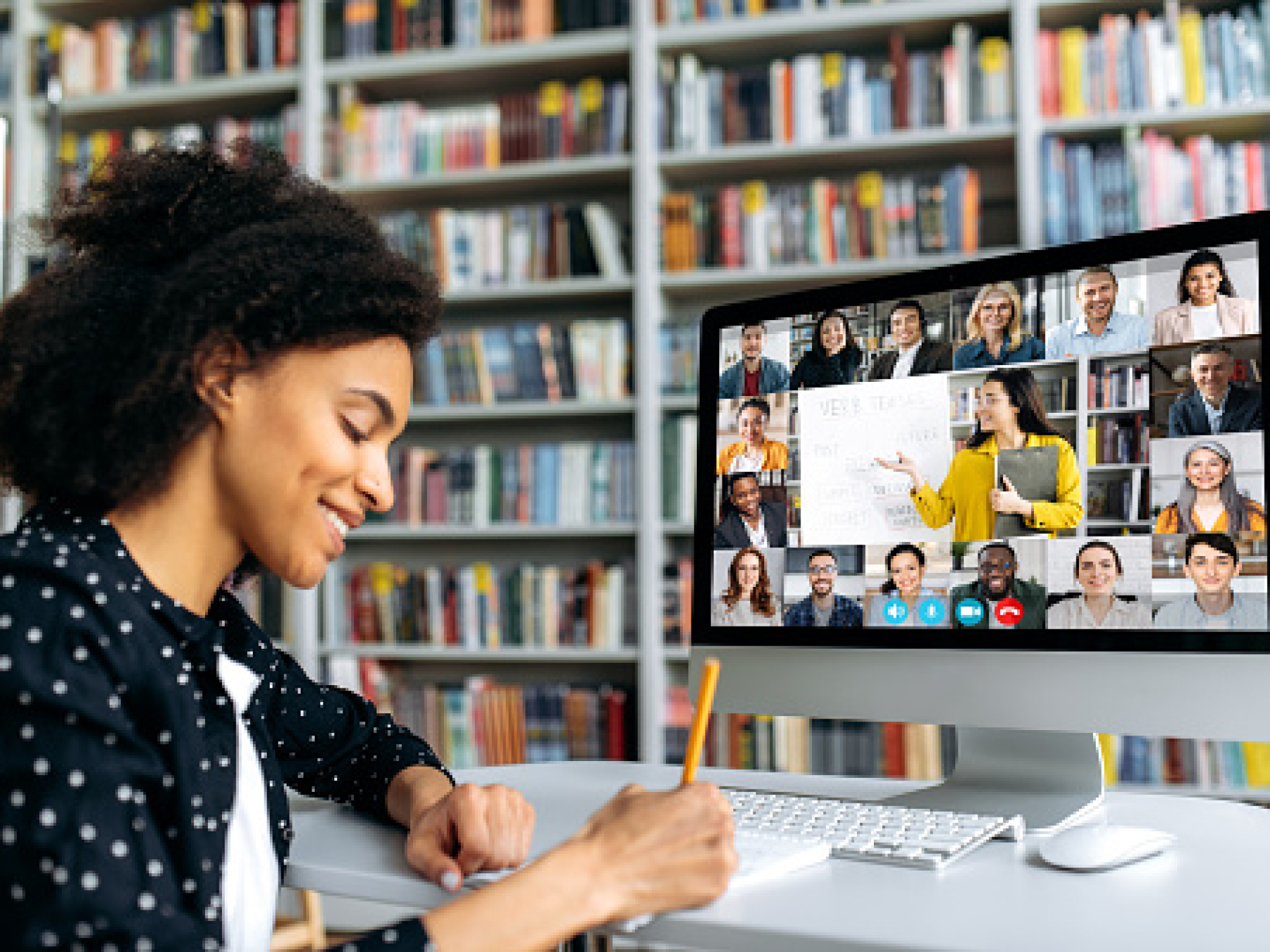While the pandemic of 2020 saw a rise in online learning, the truth is that digital curriculum and online schooling have been around for much longer. So what is a digital curriculum and why is it the key to many students’ success?
Digital curriculum refers to educational content and materials that are delivered electronically, typically through online platforms, rather than in traditional physical formats like textbooks or printed worksheets. Virtual learning is often considered the future of education, and digital curriculum plays a part, offering several advantages over in-person curriculum.
Digital curriculum provides flexibility and accessibility, allowing learners to access materials anytime, anywhere, and at their own pace, accommodating diverse learning styles and schedules. Going beyond the typical book learning, digital curriculum often incorporates interactive elements such as videos, simulations, and quizzes to enhance student engagement and understanding.
They also enable personalized learning experiences that tailor content to individual student needs and track progress more efficiently. Where books and paper curriculum are bound by their publishing date, digital curriculum can be easily updated to reflect the latest research and developments, ensuring that students have access to current and relevant information. Not to mention, digital curriculum is much more sustainable than the process of printing textbooks and paper materials.
The adaptability, interactivity, and scalability of digital curriculum makes it a compelling alternative to traditional in-person instruction, taking students beyond education and equipping them with skills for a digital era and the jobs of the future.
How to transition from traditional to digital curriculum
How can teachers, schools, and administrators take advantage of all the benefits that digital curriculum offers? Administrators can encourage adapting digital formats of classroom materials for virtual learning in schools. This strategy supports tech-driven learning and prepares the students at their schools for the future.
Transitioning from traditional curriculum to digital lessons is easier than ever. There are plenty of online resources that teachers can familiarize themselves with in order to adapt their classroom for the modern digital era of learning. Teachers can integrate digital apps and tools into their teaching methods, lesson plans, and class models.
Implementing a digital curriculum involves creating engaging digital lesson plans, which supports student engagement overall. Transitioning from traditional to digital may be a learning curve at first, but the benefits are undeniable!
What are the benefits of digital curriculum?
Online curriculum learning offers a range of benefits that cater to the diverse needs and preferences of learners. The flexibility and accessibility of digital classes allows students to access educational materials anytime, anywhere, and at their own pace. This flexibility accommodates various learning styles and schedules, empowering students to take control of their education.
Digital curriculum and online learning often incorporate interactive elements such as videos, games, and quizzes, enhancing engagement and understanding. Teachers can even use digital platforms for personalized learning with adaptive algorithms to tailor content to individual students and track progress effectively.
Benefits for students
Digital curriculum and learning offer many benefits that revolutionize the educational experience for students from elementary school, to middle school, high school, and beyond. With the power of technology at their fingertips, students can delve into a world of endless knowledge, exploring concepts through interactive simulations, immersive videos, and dynamic online resources.
Beyond the confines of traditional and often outdated curriculum, digital learning provides flexibility, allowing students to tailor their learning path to their individual needs and pace. Whether it’s reviewing concepts at their own convenience or accessing supplementary materials to deepen understanding, digital curriculum empowers students to take control of their education.
Beyond the academic benefits, digital curricula fosters collaboration and communication, breaking down geographical barriers and connecting students with peers and experts from around the globe. Through forums, virtual classrooms, and collaborative projects, students can engage in meaningful discussions, exchange ideas, and develop critical thinking and interpersonal skills essential for success in the digital age. In essence, digital curriculum and learning not only expand the horizons of what students can learn but also how they learn, equipping them with the tools and skills needed to thrive in an ever-evolving world.
Benefits for teachers
The benefits of digital learning are clear for students, but what about teachers?
Implementing digital curriculum, tools, and resources into lessons is a game changer for teachers. Utilizing a digital curriculum streamlines lesson planning and delivery, saving teachers valuable time and allowing them to personalize their students’ learning experiences.
Online courses provide access to diverse online classroom materials and resources to broaden students horizons. With digital classroom tools that assess students, create modules, and incorporate research-based learning, teachers are fully equipped to guide students like never before.
Ultimately, digital curriculum empowers teachers to create dynamic and engaging learning experiences while streamlining administrative tasks, allowing teachers to do what they do best—connect with students.
Benefits for schools
Embracing digital curriculum in schools opens up an incredible amount of possibilities, sparking excitement and innovation in both classrooms and beyond.
By tapping into cost-effective digital resources, schools can stretch their budgets while providing a wealth of educational content for students. Gone are the days of traditional boundaries; with web-based digital curriculum, learning extends far beyond the confines of the classroom, embracing remote education and reaching students wherever they may be.
But it’s not just about access; digital curriculum ignites a spirit of creativity, inspiring educators to craft lessons that are as dynamic and vibrant as the digital world itself. And the best part? It’s always evolving!
With the ability to update lesson plans on the fly, schools can stay on the cutting edge, ensuring students are equipped with the latest knowledge and skills. Plus, diving into the digital realm enhances tech integration and cultivates digital literacy, preparing students for success in a world where technology reigns supreme. It’s about opening a limitless wave of innovation and possibility that transforms education into an adventure.
How to implement digital curriculum in your classroom
Implementing digital curriculum into schools offers a dynamic approach that caters to the diverse needs and preferences of learners. By harnessing digital learning materials and digital devices, schools can accommodate various learning styles, ensuring that every student has access to resources that resonate with them.
Integrating digital technologies along with digital media fosters student engagement, transforming learning into an immersive and captivating experience. Integrating applied digital skills into lesson plans infuses real-world relevance, equipping students with essential competencies for success beyond the classroom.
In the face of evolving educational landscapes, digital curriculum can seamlessly adapt to remote learning environments, ensuring continuity and accessibility for all students, regardless of their location. Next we’ll cover some of the basics on implementing digital curriculum into your school or classroom.
Steps to integrate digital curriculum
The first step to integrating a digital curriculum is to get familiar with the digital tools and resources available. It’s important that educators choose something that aligns with their overall learning objective and any curriculum standards at the district, state, or national level if applicable.
Once you have an understanding of what is available, you can begin to incorporate and customize digital lesson plans. This is a great opportunity to utilize tablets and apps to introduce digital learning in an interactive and engaging format for students. Incorporating digital literacy skills through these types of tools is a great way to enhance tech proficiency.
Another great tool is AI. It can be used to generate personalized learning experiences, create assessments, and help educators save time. With all of these great tools and resources available, it’s crucial to remember that it takes time and training to adjust. Make sure that students and educators have adequate training and support in order to navigate whatever digital platform is implemented.
Necessary tools for digital curriculum
With so many tools and resources available it can be overwhelming to narrow down all the options. But before deciding on a digital curriculum to implement in your school or district it’s important to look for a few features:
-
- Interactivity: select a curriculum that uses audio-visual aids to engage students and enhance learning.
- Individualization: look for a curriculum with mastery-based learning that can be individualized for each student to ensure each student thrives.
- Accessibility: choose a curriculum that includes access to tools and resources that will make learning accessible to any student.
- Platform Functionality: if you don’t already have one, ask if the curriculum comes with a learning management platform to help manage the digital curriculum materials.
Educators and administrators may need to research a few different platforms or tools based on their needs. It can be daunting, but the benefits of using digital curriculum are well worth the effort it takes to find the best fit.
What to look for in a quality digital curriculum for schools
Now that you know the basics of digital curriculum, let’s take a look at what makes a quality digital curriculum. A quality digital curriculum encompasses various factors that prioritize student engagement, personalized learning, and skill development.
The curriculum should allow learners to progress at their own pace, accommodating individual learning styles and preferences. A diverse range of applied digital skills should be integrated into the curriculum, preparing students for success in the digital age.
A quality digital curriculum should be designed with consideration for diverse learner needs and abilities, ensuring inclusivity and accessibility for all students. A focus on tech literacy and digital media literacy equips students with essential competencies for navigating the digital world effectively.
It’s also important to note that the digital curriculum should align closely with educational standards and objectives, providing a structured framework for learning while allowing flexibility for innovation and creativity. By integrating these factors, a quality digital curriculum can deliver a comprehensive and engaging learning experience that empowers students to thrive in our ever-evolving society.
The role of teachers in digital curriculum
Teachers are the facilitators, guides, and mentors for students as they navigate through digital resources and tools. This requires teachers to not only have a strong understanding of technology, but also the ability to integrate it seamlessly into their teaching practices.
But teachers have a lot on their plate already—lesson planning, grading, managing classroom dynamics, and more. So how can they effectively incorporate digital curriculum into their already busy schedules? The key lies in providing teachers with the necessary support and training.
One of the most crucial aspects of successfully implementing a digital curriculum is ongoing professional development programs for teachers to ensure that they are equipped with the skills and knowledge to use digital curriculum in their classrooms. By ensuring teachers’ growth and development, schools set them up for success.
Schools and districts should consider investing in proper training and professional development opportunities. This includes not only technical training on how to use specific tools and platforms, but also pedagogical training on how to effectively integrate technology into their teaching methods.
Some providers like ASU Prep Global can provide everything schools need to implement digital curriculum, including lesson planning, digital tools, online resources, and customized professional development programs so your teachers are free to build relationships, foster collaboration, or tutor specialized content needs.
Adapting to technology-driven teaching
Adapting to technology-driven teaching involves harnessing the power of digital tools and resources to transform traditional classroom practices. Embracing digital lessons not only enhances classroom experiences but also opens up a world of possibilities for dynamic and interactive learning.
Technology empowers teachers to create engaging digital curriculum materials that captivate student interest and promote active participation. With digital curriculum, students have the flexibility to learn at their own pace, fostering a personalized learning experience that accommodates diverse learning styles and preferences.
Teachers can leverage AI and literacy apps to enhance their curriculum, providing tailored support and feedback to students while promoting digital literacy skills. Digital learning apps offer audio and visual support, catering to the needs of diverse learners and ensuring that all students have access to educational resources that suit their individual learning needs.
By incorporating all of these into the classroom, educators can effectively adapt to technology-driven teaching, creating dynamic and inclusive learning environments that prepare students for success in the digital age.
Teacher’s guide to effective digital curriculum instruction
To successfully implement a digital curriculum and harness its full potential, teachers can follow several key strategies:
- Get familiar with the digital tools and platforms available for curriculum instruction, such as learning management systems, online resources, and interactive activities.
- Choose the appropriate digital tools and resources that align with your curriculum objectives and students’ learning needs.
- Develop a clear and organized structure for your digital curriculum, including lesson plans, assignments, assessments, and any necessary instructions or guidelines for students.
- Communicate clearly with students about expectations for their participation in the digital curriculum instruction, including deadlines, communication channels, and technological requirements.
- Provide opportunities for students to practice using the digital tools and resources before starting the actual instruction to ensure they are comfortable with them.
- Incorporate a variety of engaging multimedia elements into your digital instruction to enhance student engagement and understanding, such as videos, interactive games, simulations, and virtual field trips.
- Utilize student data from digital platforms to track progress and identify areas where additional support may be needed.
- Facilitate discussions and collaboration among students through online forums or video conferencing tools to promote peer-to-peer learning.
- Regularly check in with students to assess their understanding of the content and make any necessary adjustments to improve their learning experience.
- Continuously seek out new resources and tools to keep your digital curriculum current and effective in meeting the needs of your students.
To get started with digital curriculum, teachers start by exploring tutorials tailored to their specific needs and objectives. ASU Prep Global has experience helping hundreds of educators get acclimated to digital curriculum, partnering with schools and teachers for professional learning and resources.
Challenges and solutions in implementing digital curriculum
As with all changes, implementing a digital curriculum is not without its challenges. But, we have the solutions you need to ensure a seamless transition and overcome these challenges.
Challenges |
Solutions |
|---|---|
| Limited Access to Technology |
|
| Teacher Training and Support |
|
| Digital Equity and Inclusion |
|
| Data Privacy and Security Concerns |
|
| Student Engagement and Motivation |
|
By addressing these challenges and implementing proactive solutions, educators can unlock the full potential of their digital curriculum, fostering a dynamic and inclusive learning environment for all students.
Looking to license K–12 digital curriculum?
As educators, there are many factors to consider when integrating digital curriculum and virtual learning into your school. ASU Prep Global can help with comprehensive support to make digital learning hassle-free. Whether you need K–12 digital course licensing or an entire learning management system with teacher training, tech support, digital tools, and more, we can customize delivery based on your school or district’s online course needs.
ASU Prep Global partners with other K–12 schools to build new models of educational success, embed early college experiences and provide access to the latest innovative technologies, digital courseware, and professional development. We’re more than a curriculum provider—we’re an innovation partner to top schools and school districts.
We help our partners create high-impact, high-quality digital education that meets the unique needs of their learners and staff. For more than a decade, we’ve partnered with school leaders to help innovate learning for K–12 students and educators through Arizona State University led research, proven effective learning practices, and industry-leading online education technology.
Digital curriculum FAQs
What is digital learning curriculum?
Digital learning curriculum refers to educational materials and resources that are designed to be accessed and used online. This can include interactive lessons, videos, assessments, and other digital tools that support student learning. Incorporating digital curriculum can help prepare students and allow them to work at their own pace and access additional resources or support if needed. This can be especially beneficial for students who may struggle in a traditional classroom setting.
What are the benefits of using digital curriculum?
There are many benefits to incorporating digital curriculum into classroom instruction. For one, it allows for a more personalized and engaging learning experience for students. Digital materials often include multimedia elements such as videos, simulations, and games which can make learning more interactive and fun. Additionally, digital curriculum provides access to a wide range of resources that may not be available in traditional textbooks or print materials. This can expose students to diverse perspectives and enable them to explore topics in depth.
What kind of technologies are used in digital curriculum teaching?
There are various technologies that can be used in digital curriculum teaching, depending on the specific needs and goals of the lesson or course. Some common examples include learning management systems (LMS), online educational platforms, interactive whiteboards, video conferencing, and even virtual reality tools.





